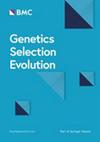两个猪种群中等位基因频率和遗传结构因选择而发生的变化
IF 3.1
1区 农林科学
Q1 AGRICULTURE, DAIRY & ANIMAL SCIENCE
引用次数: 0
摘要
遗传选择通过提高有利等位基因的频率来改善种群。因此,了解和监测等位基因频率的变化对于更深入地了解选择的长期效应非常重要。本研究旨在调查等位基因频率和全基因组关联研究(GWAS)结果的变化,以及这两者之间的关系。研究对象是基于广泛选择指数进行选择的两个母猪品系。基因型和表型可在 2015 年至 2021 年间获得。在这两个品系中都观察到了等位基因频率随时间推移而发生的一些巨大变化。最大的等位基因频率变化并不比基于基因下降模拟的预期漂移大,但平均等位基因频率变化却比选择大。此外,在选择性状的 GWAS 中发现了几个重要区域,但这些区域与等位基因频率变化较大的区域并不重叠。在两个品系的选择指数(包括多个性状)中都没有发现显著的 GWAS 区域,这表明该指数受到许多影响较小的位点的影响。此外,许多显著区域与其他被选择的性状呈现出多效性,而且往往是拮抗性。这就降低了这些区域的选择压力,从而解释了为什么这些区域仍然存在分离现象,尽管这些性状已经经过了几代的选择。在不同年份,曼哈顿地块只发生了很小的变化,这表明遗传结构相当稳定。在等位基因频率变化最大的区域中,没有发现任何受选择性状的重要 GWAS 区域,而且在所有性状中,标记关联的显著性水平与等位基因频率在一代中的变化之间的相关性接近于零。此外,等位基因频率的最大变化可以用漂移来解释,而不一定是选择的结果。这可能是因为选择作用于一个广泛的指数,而在这个指数上没有发现显著的全球基因组分析区域。我们的研究结果表明,在广泛的指数上进行选择会将选择压力分散到整个基因组,从而限制等位基因频率的变化。本文章由计算机程序翻译,如有差异,请以英文原文为准。
Changes in allele frequencies and genetic architecture due to selection in two pig populations
Genetic selection improves a population by increasing the frequency of favorable alleles. Understanding and monitoring allele frequency changes is, therefore, important to obtain more insight into the long-term effects of selection. This study aimed to investigate changes in allele frequencies and in results of genome-wide association studies (GWAS), and how those two are related to each other. This was studied in two maternal pig lines where selection was based on a broad selection index. Genotypes and phenotypes were available from 2015 to 2021. Several large changes in allele frequencies over the years were observed in both lines. The largest allele frequency changes were not larger than expected under drift based on gene dropping simulations, but the average allele frequency change was larger with selection. Moreover, several significant regions were found in the GWAS for the traits under selection, but those regions did not overlap with regions with larger allele frequency changes. No significant GWAS regions were found for the selection index in both lines, which included multiple traits, indicating that the index is affected by many loci of small effect. Additionally, many significant regions showed pleiotropic, and often antagonistic, associations with other traits under selection. This reduces the selection pressure on those regions, which can explain why those regions are still segregating, although the traits have been under selection for several generations. Across the years, only small changes in Manhattan plots were found, indicating that the genetic architecture was reasonably constant. No significant GWAS regions were found for any of the traits under selection among the regions with the largest changes in allele frequency, and the correlation between significance level of marker associations and changes in allele frequency over one generation was close to zero for all traits. Moreover, the largest changes in allele frequency could be explained by drift and were not necessarily a result of selection. This is probably because selection acted on a broad index for which no significant GWAS regions were found. Our results show that selecting on a broad index spreads the selection pressure across the genome, thereby limiting allele frequency changes.
求助全文
通过发布文献求助,成功后即可免费获取论文全文。
去求助
来源期刊

Genetics Selection Evolution
生物-奶制品与动物科学
CiteScore
6.50
自引率
9.80%
发文量
74
审稿时长
1 months
期刊介绍:
Genetics Selection Evolution invites basic, applied and methodological content that will aid the current understanding and the utilization of genetic variability in domestic animal species. Although the focus is on domestic animal species, research on other species is invited if it contributes to the understanding of the use of genetic variability in domestic animals. Genetics Selection Evolution publishes results from all levels of study, from the gene to the quantitative trait, from the individual to the population, the breed or the species. Contributions concerning both the biological approach, from molecular genetics to quantitative genetics, as well as the mathematical approach, from population genetics to statistics, are welcome. Specific areas of interest include but are not limited to: gene and QTL identification, mapping and characterization, analysis of new phenotypes, high-throughput SNP data analysis, functional genomics, cytogenetics, genetic diversity of populations and breeds, genetic evaluation, applied and experimental selection, genomic selection, selection efficiency, and statistical methodology for the genetic analysis of phenotypes with quantitative and mixed inheritance.
 求助内容:
求助内容: 应助结果提醒方式:
应助结果提醒方式:


